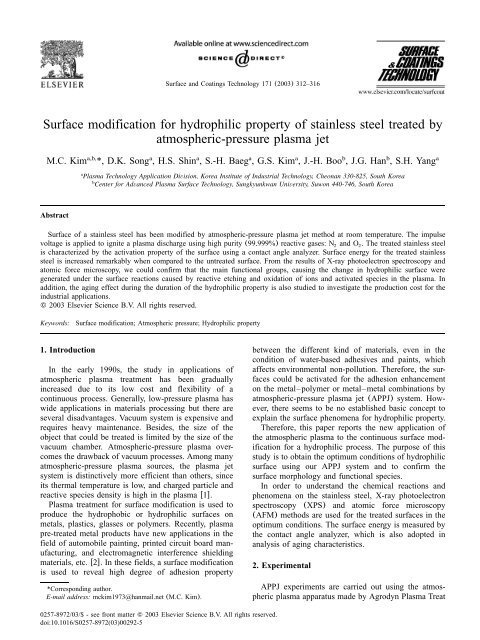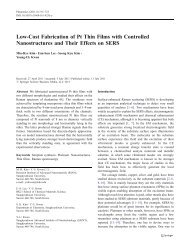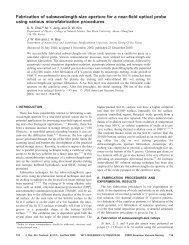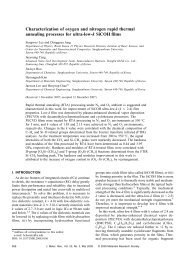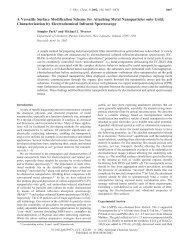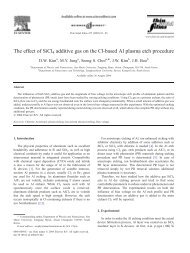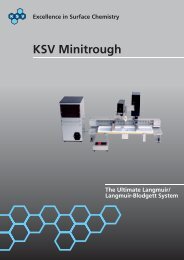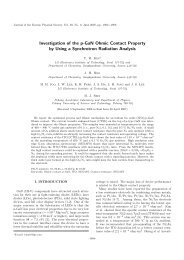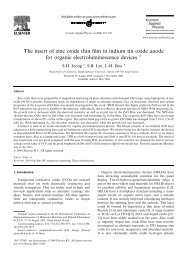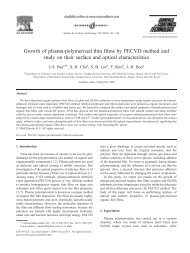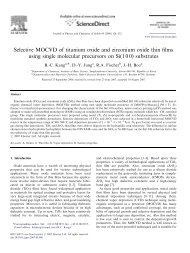Surface modification for hydrophilic property of stainless steel ...
Surface modification for hydrophilic property of stainless steel ...
Surface modification for hydrophilic property of stainless steel ...
You also want an ePaper? Increase the reach of your titles
YUMPU automatically turns print PDFs into web optimized ePapers that Google loves.
<strong>Surface</strong> and Coatings Technology 171 (2003) 312–316<strong>Surface</strong> <strong>modification</strong> <strong>for</strong> <strong>hydrophilic</strong> <strong>property</strong> <strong>of</strong> <strong>stainless</strong> <strong>steel</strong> treated byatmospheric-pressure plasma jetM.C. Kim*, D.K. Song , H.S. Shin , S.-H. Baeg , G.S. Kim , J.-H. Boo , J.G. Han , S.H. Yanga,b, a a a a b b aaPlasma Technology Application Division, Korea Institute <strong>of</strong> Industrial Technology, Cheonan 330-825, South KoreabCenter <strong>for</strong> Advanced Plasma <strong>Surface</strong> Technology, Sungkyunkwan University, Suwon 440-746, South KoreaAbstract<strong>Surface</strong> <strong>of</strong> a <strong>stainless</strong> <strong>steel</strong> has been modified by atmospheric-pressure plasma jet method at room temperature. The impulsevoltage is applied to ignite a plasma discharge using high purity (99.999%) reactive gases: N2 and O 2. The treated <strong>stainless</strong> <strong>steel</strong>is characterized by the activation <strong>property</strong> <strong>of</strong> the surface using a contact angle analyzer. <strong>Surface</strong> energy <strong>for</strong> the treated <strong>stainless</strong><strong>steel</strong> is increased remarkably when compared to the untreated surface. From the results <strong>of</strong> X-ray photoelectron spectroscopy andatomic <strong>for</strong>ce microscopy, we could confirm that the main functional groups, causing the change in <strong>hydrophilic</strong> surface weregenerated under the surface reactions caused by reactive etching and oxidation <strong>of</strong> ions and activated species in the plasma. Inaddition, the aging effect during the duration <strong>of</strong> the <strong>hydrophilic</strong> <strong>property</strong> is also studied to investigate the production cost <strong>for</strong> theindustrial applications. 2003 Elsevier Science B.V. All rights reserved.Keywords:<strong>Surface</strong> <strong>modification</strong>; Atmospheric pressure; Hydrophilic <strong>property</strong>1. IntroductionIn the early 1990s, the study in applications <strong>of</strong>atmospheric plasma treatment has been graduallyincreased due to its low cost and flexibility <strong>of</strong> acontinuous process. Generally, low-pressure plasma haswide applications in materials processing but there areseveral disadvantages. Vacuum system is expensive andrequires heavy maintenance. Besides, the size <strong>of</strong> theobject that could be treated is limited by the size <strong>of</strong> thevacuum chamber. Atmospheric-pressure plasma overcomesthe drawback <strong>of</strong> vacuum processes. Among manyatmospheric-pressure plasma sources, the plasma jetsystem is distinctively more efficient than others, sinceits thermal temperature is low, and charged particle andreactive species density is high in the plasma w1x.Plasma treatment <strong>for</strong> surface <strong>modification</strong> is used toproduce the hydrophobic or <strong>hydrophilic</strong> surfaces onmetals, plastics, glasses or polymers. Recently, plasmapre-treated metal products have new applications in thefield <strong>of</strong> automobile painting, printed circuit board manufacturing,and electromagnetic interference shieldingmaterials, etc. w2x. In these fields, a surface <strong>modification</strong>is used to reveal high degree <strong>of</strong> adhesion <strong>property</strong>*Corresponding author.E-mail address: mckim1973@hanmail.net (M.C. Kim).between the different kind <strong>of</strong> materials, even in thecondition <strong>of</strong> water-based adhesives and paints, whichaffects environmental non-pollution. There<strong>for</strong>e, the surfacescould be activated <strong>for</strong> the adhesion enhancementon the metal–polymer or metal–metal combinations byatmospheric-pressure plasma jet (APPJ) system. However,there seems to be no established basic concept toexplain the surface phenomena <strong>for</strong> <strong>hydrophilic</strong> <strong>property</strong>.There<strong>for</strong>e, this paper reports the new application <strong>of</strong>the atmospheric plasma to the continuous surface <strong>modification</strong><strong>for</strong> a <strong>hydrophilic</strong> process. The purpose <strong>of</strong> thisstudy is to obtain the optimum conditions <strong>of</strong> <strong>hydrophilic</strong>surface using our APPJ system and to confirm thesurface morphology and functional species.In order to understand the chemical reactions andphenomena on the <strong>stainless</strong> <strong>steel</strong>, X-ray photoelectronspectroscopy (XPS) and atomic <strong>for</strong>ce microscopy(AFM) methods are used <strong>for</strong> the treated surfaces in theoptimum conditions. The surface energy is measured bythe contact angle analyzer, which is also adopted inanalysis <strong>of</strong> aging characteristics.2. ExperimentalAPPJ experiments are carried out using the atmosphericplasma apparatus made by Agrodyn Plasma Treat0257-8972/03/$- see front matter 2003 Elsevier Science B.V. All rights reserved.doi:10.1016/S0257-8972(03)00292-5
M.C. Kim et al. / <strong>Surface</strong> and Coatings Technology 171 (2003) 312–316313In comparison, the <strong>steel</strong> products normally have a roughsurface. All the treatments are carried out under theroom temperature. The aging tests are per<strong>for</strong>med in theconstant conditions <strong>of</strong> the relative humidity <strong>of</strong> 64% <strong>for</strong>4 days.3. Results and discussion3.1. Contact angle analysis and optimum condition <strong>for</strong><strong>hydrophilic</strong> <strong>property</strong>As a first step <strong>of</strong> our analysis, we per<strong>for</strong>med contactangle analysis to obtain the optimized conditions <strong>for</strong> a<strong>hydrophilic</strong> surface with respect to the nozzle-to-surfaceFig. 1. Contact angle data under different nozzle velocity (a) and gapdistance (b). Contact angle images (c) be<strong>for</strong>e treatment and aftertreatment in the optimum conditions <strong>of</strong> NSG 5 mm and NMV <strong>of</strong> 10mmys.GmbH, Bielefeld, Germany. The power <strong>for</strong> the plasmageneration and sustenance is supplied with the impulsevoltage into the jet-nozzle electrode via the trans<strong>for</strong>mer.The maximum voltage is applied into the jet-nozzleelectrode. The output frequency is approximately 10 kVfrom peak to peak at the frequency <strong>of</strong> 16–20 kHz. Thelength <strong>of</strong> plasma jet flame is approximately 30 mm andthe diameter is 10 mm. Mixed N and O with a high2 2degree <strong>of</strong> purity (99.999%) are used as reactive gaseswith the ratio <strong>of</strong> N :O s4:1 similar to air. The gases2 2are controlled by manual flow-controller and constantlyflowed into the jet-nozzle <strong>for</strong> a plasma ignition. The jetnozzlebody is fixed on the frame <strong>of</strong> the X–Y movingtable made to treat large-area substrate such as web orpolymer films. The <strong>stainless</strong> <strong>steel</strong> is sequentially cleanedin acetone, methyl alcohol, and de-ionized water byultrasonic cleaning method. For clearer confirmation onAFM results, silicon (100) wafer is also cleaned witha <strong>for</strong>e-mentioned method and treated in the plasmaunder the same conditions due to its highly flat surface.Fig. 2. (a) High-resolution XPS analysis <strong>of</strong> C ls (a), Ols(b), andFe 2p on the same surface as Fig. 1c.3y2
314 M.C. Kim et al. / <strong>Surface</strong> and Coatings Technology 171 (2003) 312–316Table 1<strong>Surface</strong> compositions <strong>of</strong> plasma treated surfaces by XPS analysisat.% C O Fe CrUntreated SUS 41.6 47.8 4.5 6.1Treated SUS 24.7 59.3 16 0gap (NSG) and nozzle velocity. According to the numericalsimulation <strong>of</strong> the concentrations <strong>of</strong> species by Jeongw1x, the effluent <strong>of</strong> the plasma jet depends on thefunction <strong>of</strong> distance between nozzle and surface. Fromthis dependency, we could realize that the concentrations<strong>of</strong> activated species like O and N atoms as well as themetastable oxygen and nitrogen molecules in our studyshow non-equilibrium distribution. The plasma jet ispartially under the condition <strong>of</strong> atmospheric pressure. Inaddition, the efficiency <strong>of</strong> surface <strong>modification</strong> is als<strong>of</strong>ollowed by the treatment time per unit area on thesurface and controlled by the moving velocity <strong>of</strong> thenozzle. Fig. 1a–c shows the optimum conditions andcontact angle images <strong>for</strong> the surface activation withincreasing the NSG distance and the nozzle movingvelocity (NMV) using the reactive mixed gases in theratio <strong>of</strong> N 2:O2s4:1. As the figures indicate, the contactangles are increased with increasing the NSG and NMVand it gives a good account <strong>for</strong> the theory as mentionedabove. The best surface energy calculated from thecontact angle value is approximately 71.49 mNym inthe conditions <strong>of</strong> 10 mm (NSG) and5mmys (NMV).Below the conditions <strong>of</strong> 10 mm (NSG) and5mmys(NMV), the treated <strong>steel</strong> substrates are damaged due tothe plasma heat and arc generated in the end <strong>of</strong> nozzletip. Hence it is appropriate to neglect the values belowthat conditions.3.2. The analysis <strong>of</strong> surface activation by X-ray photoelectronspectroscopyIn the optimum conditions obtained from the contactangle data, the <strong>steel</strong> sheets with 0.2 mm thickness aretreated using the mixed gases <strong>of</strong> N 2:O2s4:1. Thesubstrate is compared with the untreated <strong>steel</strong>. Theresults <strong>of</strong> these measurements are shown in Fig. 2. Fig.2a indicates the presence <strong>of</strong> C 1s core-level XPS spectraobtained from the <strong>stainless</strong> <strong>steel</strong>s after the treatment. Itis considered that the carbon is caused by the impuritycontained <strong>steel</strong> substrates and the air contamination suchas CO2and CO molecules, which could be broken topieces or excited to metastable states by heat andcollisions in the plasma jet. From the curve fitting <strong>of</strong>Fig. 3. The section (a) and three dimensional morphology (c) images <strong>of</strong> untreated <strong>stainless</strong> <strong>steel</strong> surface. After treating, the section (b) and threedimensional morphology (d) images by AFM.
M.C. Kim et al. / <strong>Surface</strong> and Coatings Technology 171 (2003) 312–316315C_ O, C–C, C–O bonds, the adsorption and <strong>for</strong>mation<strong>of</strong> new functional groups can be shown, which couldsupport a <strong>hydrophilic</strong> surface w3–5x, In the cases <strong>of</strong> O1s core-level spectra in Fig. 2b, several chemical bindingstates are also observed in the range <strong>of</strong> 530–533 eV,indicating the binding energy <strong>of</strong> the Fe2O 3, FeOOH, andHOw6x. 2 Fe 2p3y2core-level spectra are shown in Fig.2c, which has a connection with the decomposition <strong>of</strong>O 1s peak w6x. Thus it is clear that the surface oxidationis occurred occasionally by O atoms, O2molecules, andthe other activated species including a carbon on thesubstrate and additionally new functional groups <strong>for</strong><strong>hydrophilic</strong> surfaces were generated. Under the presentresults, the nitrogen elements with the types <strong>of</strong> atomsand metastable species are absent on the <strong>steel</strong> surfaces.It can be interpreted by collision cross-sections between2 2N 2 (0.43 nm ) and O 2 (0.40 nm ), and highly chemicalactivity with three bonds in the atomic phase on thenitrogen gas. It could be inferred from these reasonsthat the amount <strong>of</strong> dissociated N atoms could be largerthan the oxygen atoms, and the atoms and metastablespecies are combined with nearby N, O, C, andyoractivated molecules be<strong>for</strong>e arriving at surface. From theresults <strong>of</strong> Table 1, it could be expected that the nitrogenspecies activated could easily arrive and bombard thesurface, leading to the effects <strong>of</strong> sputtering and reactiveetching. On the other hand, it is considered that oxygenspecies activated are in the role <strong>of</strong> surface oxidation,affecting <strong>hydrophilic</strong> <strong>property</strong>. There<strong>for</strong>e, two reactionsoccurred to increase contact angle on surface; one is thecleaning effect by nitrogen atoms and activated species.The other one is surface oxidation by oxygen atoms andactivated species. These results could also be explainedby a topography and section analysis using AFM.3.3. Analysis <strong>of</strong> surface and section morphology byatomic <strong>for</strong>ce microscopyFig. 3a, b and c, d show the section images and thethree-dimensional morphologies <strong>of</strong> both untreated andtreated substrates in optimized conditions. After thetreatment, the new grains appeared densely in comparisonwith the untreated morphology. Besides the surfaceis also modified into sharp and the height <strong>of</strong> prominencewere decreased as a result from the section analysis. Inaddition, the topographic properties are analyzed usingthe treated silicon (100) wafer as a substrate in thesame conditions due to its advantage <strong>of</strong> flatness. Theresults are shown in the Fig. 4a and c. These figuresclearly show that the <strong>stainless</strong> <strong>steel</strong> and silicon surfacesare bombarded and etched by nitrogen molecules mainly,but, at the same time, partially the oxide grains containedcarbon are grown on the surface. In this respect, theobtained results are corresponded to interpretation <strong>of</strong>XPS data. To confirm the effects <strong>of</strong> mixed gases ratio,we also have treated the silicon substrate in the condition<strong>of</strong> N 2:O2s1:4 and showed in Fig. 4b and d. Thesefigures reveal that the grain growth is increased withFig. 4. The section (a) and three dimensional morphology (c) images <strong>of</strong> treated substrate in the condition <strong>of</strong> N :O s4:l on silicon (100) wafer.2 2The section (b) and three dimensional morphology (d) images <strong>of</strong> silicon (100) wafer in the condition <strong>of</strong> N :O s1:4 by AFM analysis.2 2
316 M.C. Kim et al. / <strong>Surface</strong> and Coatings Technology 171 (2003) 312–316Fig. 5. Contact angle data obtained under different exposed time during 4 days <strong>of</strong> the treated surface by APPJ in the optimum conditions.increasing the amount <strong>of</strong> oxygen gas and the bombardingand etching reactions are decreased with decreasing thenitrogen amount. The results <strong>of</strong> contact angle analysis<strong>of</strong> treated substrates are very similar under the treatmentconditions <strong>of</strong> N :O s4:1 and N :O s1:4 on <strong>steel</strong> and2 2 2 2silicon. In the case <strong>of</strong> <strong>stainless</strong> <strong>steel</strong>, the contact anglesare us15.07 and 14.05, respectively, in the conditions<strong>of</strong> N :O s4:1 and N :O s1:4. Both results <strong>of</strong> silicon2 2 2 2substrates are also very similar as below us10. Thisresult could be interpreted in the following way; thesurface activation was governed by the effects <strong>of</strong> bombardingand etching reactions <strong>of</strong> nitrogen molecules inthe condition <strong>of</strong> N 2:O2s4:1, to the contrary, the effects<strong>of</strong> grain growth composed to oxide contained carbon byO atoms, O , O , O<strong>of</strong> N 2:O2sl:4 mainly w1x., H O and CO in the conditionq y 2q2 23.4. Aging test <strong>for</strong> application to industrial processIn the industrial applications, the aging <strong>property</strong> isimportant <strong>for</strong> the maintenance during the long time withthe high surface energy because it has a deep withproduction cost and storage. There<strong>for</strong>e, we have measuredcontact angles <strong>for</strong> 4 days using the substratestreated in the optimized conditions as mentioned aboveat room temperature and relative humidity <strong>of</strong> 64%. Fig.5 shows that the surface energy is decreased within 15h with respect to the increase in exposed time. There<strong>for</strong>e,the highly activated surfaces could react rapidly evenwith stable molecules due to its high surface energiesas discussed in XPS and AFM results.4. ConclusionsThe <strong>stainless</strong> <strong>steel</strong> substrates was successfully modifiedinto <strong>hydrophilic</strong> surfaces using mixed gases <strong>of</strong>nitrogen and oxygen by APPJ method. The highestsurface energy <strong>for</strong> adhesion enhancement was 71.49mNym at the NSG <strong>of</strong> 5 mm in the condition <strong>of</strong> NMV<strong>of</strong> 10 mmys, respectively. The results <strong>of</strong> XPS data andAFM analysis reveal that activated nitrogen and oxygenspecies could etch and oxidize the surface, respectively,resulting in the increased surface energies. The agingtest results show that the highly activated surface isobtained and has a short duration time <strong>of</strong> approximately15 h in air condition after the treatments. In conclusionwe could understand the surface phenomena and confirmthat the <strong>stainless</strong> <strong>steel</strong> could be easily treated to <strong>hydrophilic</strong><strong>property</strong> under the air condition by plasma jetmethod.Referencesw1x A. Schutze, J.Y. Jeong, S.E. Babayan, J. Park, G.S. Sewyn,R.F. Hicks, IEEE Trans. Plasma Sci. 26 (1998) 1685.w2x O. Goossens, E. Dekempeneer, D. Vangeneugden, R.Van de Leest, C. Leys, Surf. Coat. Technol. 142–144 (2001)474.w3x I. Olefjord, L. Wegrelius, Corros. Sci. 38 (1996) 1208.w4x C. Duret-Thual, D. Costa, W.P. Yang, P. Marcus, Corros. Sci.39 (1997) 927.w5x A. Claes-Ol<strong>of</strong>, Olsson Corros. Sci. 37 (1995) 473.w6x A. Pereira, A. Cros, Ph. Delaporte, W. Marine, M. Sentis,Appl. Surf. Sci. 8121 (2002) 3.


